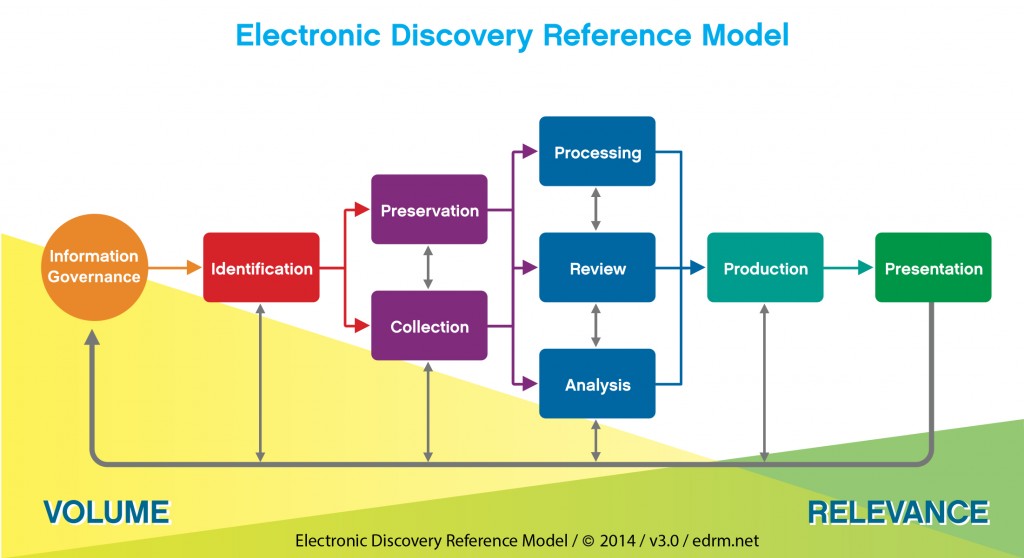Updated model reflects current electronic discovery process and philosophy\r\n\r\nSAINT PAUL, Minn. – May 19, 2014 – EDRM, the leading standards organization for the e-discovery market, today announced the release of Version 3 of the Electronic Discovery Reference Model (EDRM) diagram. Originally published in 2006, the framework is a popular tool used by legal professionals and others involved in e-discovery to help clarify processes and expectations among project stakeholders.\r\n\r\nVersion 3 of the EDRM diagram offers significant updates, primarily to express the importance of information governance (IG) as a key piece of the electronic discovery process. The new model is as follows:\r\n\r\n \r\n\r\nThe leftmost item in the model has been renamed “Information Governance” and its shape has been changed from a rectangle to a circle. These edits better align this diagram with EDRM’s Information Governance Reference Model (IGRM). The adoption of a circle also is meant to show that every well-managed e-discovery process should start and end with sound information governance.\r\n\r\nIn addition, the line from Presentation to Information Governance has been widened. This emphasizes that no e-discovery process is fully completed – no matter at what stage it stops – until it has been looped back to IG.\r\n\r\nThe final update to the diagram is the increased size of the words “VOLUME” and “RELEVANCE” in the bottom corners of the diagram. This change draws greater attention to the two core objectives driving most e-discovery projects.\r\n\r\nThe process of updating the diagram began during a group session at the EDRM Mid-Year Meeting in fall 2013. Members agreed that with the increased attention on IG, an update to the popular model was necessary. Much time and effort were invested in creating a new diagram that accurately reflects the current environment. EDRM would like to acknowledge and thank member Wade Peterson of the firm Bowman and Brooke, LLP, who facilitated the model’s graphic design changes. The new diagram was shared at last month’s EDRM Annual Kick-Off Meeting where members approved the updated model.\r\n\r\nThe new (Version 3) EDRM diagram is available free of charge and can be downloaded in a variety of file formats from the EDRM website. Use of the diagram is subject to a Creative Commons Attribution 3.0 Unported License, which means it may be shared, remixed, or used commercially as long as attribution is provided by citing “EDRM (edrm.net).”\r\n\r\nAbout EDRM\r\nEDRM creates practical resources to improve e-discovery and information governance. Launched in May 2005, EDRM was established to address the lack of standards and guidelines in the e-discovery market. In January 2006, EDRM published the Electronic Discovery Reference Model, followed by additional resources such as IGRM, CARRM and the Talent Task Matrix. Since its launch, EDRM has comprised 276 organizations, including 179 service and software providers, 69 law firms, three industry groups, one educational institution and 24 corporations involved with e-discovery and information governance.\r\n\r\nContact\r\nTom Gelbmann\r\nEDRM, LLC\r\nPh: 651-483-0022\r\nEmail: tom@edrm.net
\r\n\r\nThe leftmost item in the model has been renamed “Information Governance” and its shape has been changed from a rectangle to a circle. These edits better align this diagram with EDRM’s Information Governance Reference Model (IGRM). The adoption of a circle also is meant to show that every well-managed e-discovery process should start and end with sound information governance.\r\n\r\nIn addition, the line from Presentation to Information Governance has been widened. This emphasizes that no e-discovery process is fully completed – no matter at what stage it stops – until it has been looped back to IG.\r\n\r\nThe final update to the diagram is the increased size of the words “VOLUME” and “RELEVANCE” in the bottom corners of the diagram. This change draws greater attention to the two core objectives driving most e-discovery projects.\r\n\r\nThe process of updating the diagram began during a group session at the EDRM Mid-Year Meeting in fall 2013. Members agreed that with the increased attention on IG, an update to the popular model was necessary. Much time and effort were invested in creating a new diagram that accurately reflects the current environment. EDRM would like to acknowledge and thank member Wade Peterson of the firm Bowman and Brooke, LLP, who facilitated the model’s graphic design changes. The new diagram was shared at last month’s EDRM Annual Kick-Off Meeting where members approved the updated model.\r\n\r\nThe new (Version 3) EDRM diagram is available free of charge and can be downloaded in a variety of file formats from the EDRM website. Use of the diagram is subject to a Creative Commons Attribution 3.0 Unported License, which means it may be shared, remixed, or used commercially as long as attribution is provided by citing “EDRM (edrm.net).”\r\n\r\nAbout EDRM\r\nEDRM creates practical resources to improve e-discovery and information governance. Launched in May 2005, EDRM was established to address the lack of standards and guidelines in the e-discovery market. In January 2006, EDRM published the Electronic Discovery Reference Model, followed by additional resources such as IGRM, CARRM and the Talent Task Matrix. Since its launch, EDRM has comprised 276 organizations, including 179 service and software providers, 69 law firms, three industry groups, one educational institution and 24 corporations involved with e-discovery and information governance.\r\n\r\nContact\r\nTom Gelbmann\r\nEDRM, LLC\r\nPh: 651-483-0022\r\nEmail: tom@edrm.net


